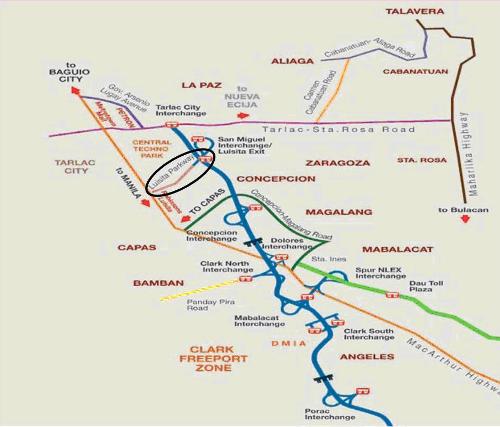The 94-kilometer Subic-Clark-Tarlac Expressway (SCTEx) is presently the longest highway in the Philippines. It connects the Subic Bay Freeport, the Clark Freeport, and Tarlac City. The Bases Conversion Development Authority (BCDA) was the government arm that oversaw the implementation of the project. According to the BCDA, 85% of the P27 billion cost to build the SCTEx was financed through funds borrowed by the government from the Japan Bank for International Cooperation (JBIC).
 Click here to view full SCTEX map
Click here to view full SCTEX map The SCTEx has 11 exits starting from Subic in the south and ending in Tarlac City in the north. 1. Tipo Exit (Hermosa, Bataan) – connects to the Subic Bay Freeport Expressway 2. Dinalupihan Exit (Dinalupihan, Bataan) – connects to the Bataan Provincial Expressway 3. Floridablanca Exit (Floridablanca, Pampanga) – connects to Floridablanca town proper and the Basa Air Base 4. Porac Exit (Porac, Pampanga) – connects to Porac town proper 5. Clark South Exit (Clark Freeport, Angeles City, Pampanga) – connects to the Clark Freeport 6. Mabalacat Exit (Clark Freeport, Angeles City, Pampanga) – connects to the Clark Spur Road then the North Luzon Expressway (NLEX) 7. Clark North Exit (Clark Freeport, Angeles City, Pampanga) – connects to the Clark Freeport and the future passenger terminal of the Diosdado Macapagal Airport in Clark 8. Dolores Exit (Mabalacat, Pampanga) – connects to Mabalacat town proper and McArthur Highway 9. Concepcion Exit (Concepcion, Tarlac) – connects with the Concepcion Magalang Road 10. San Miguel/Luisita Exit (Tarlac City, Tarlac) – connects to the Central Techno Park of Hacienda Luisita 11. Tarlac City Exit (Tarlac City, Tarlac) - connects to the Tarlac-Santa Rosa Road (coming from the south, turning right on this road leads to La Paz town proper, while turning left leads to Tarlac City proper)
Issues regarding the Luisita Exit raised by Cavite Rep. Crispin Remulla: 1. The farm workers of Hacienda Luisita were not given their 33% share in the P83 million the government paid Hacienda Luisita, Inc (HLI) for road right-of-way to build the Luisita interchange. In a statement emailed to GMANews.TV on February 6, 2010, the office of Senator Noynoy Aquino said the farm workers were given 3% of the amount paid, while the balance was used to pay off debts of HLI. “This decision was arrived at by the board, which consists of members who are farmer beneficiaries," the statement said. The 3% is based on the farm workers’ mandatory share in the hacienda’s gross production output that was included in Hacienda Luisita’s stock distribution agreement in 1989 as required by Section 32 of the Comprehensive Agrarian Reform Program (CARP). Lawyers assisting the farm workers contend that the sale of land to the government for the road right-of-way cannot be treated like a regular sugarcane production sale subject to the 3% sharing scheme, because the sale of the land was in fact a divestment of capital and should be subject to the 33% equity share of the farm workers.
The farmers liable for debt?
To illustrate how HLI’s debt complicates land distribution in Hacienda Luisita, it is worth revisiting the mortgages that the Department of Agrarian Reform (DAR) discovered after it recommended the revocation of Luisita’s Stock Distribution Option (SDO) in 2005. On October 4, 2005, the Philippine Daily Inquirer reported that HLI spokesperson Vigor Mendoza confirmed rumors that certain portions of the hacienda technically belonged to banks because they were mortgaged by management when losses were suffered by the company. Romeo Capulong, one of the lawyers of Luisita’s farm workers, said that the farm workers were unaware of these loans and did not benefit from them, therefore it was unfair to force them to assume the burden of these liabilities. “Let it be the personal obligation of those who benefited from the loans," Capulong said, referring to the Cojuangco-led management of HLI. Capulong urged the DAR to ask HLI management to give a full accounting of all operations from 1989 to 2005 and stop all further transactions involving the sale, joint venture, lease, or mortgage of the disputed hacienda’s land. Because of the mortgages, the banks became additional claimants to portions of Hacienda Luisita. Titles for certain parcels were transferred to banks through dacion en pago when some loans could no longer be paid.
The Luisita interchange directly connects the SCTEx to a private road of Hacienda Luisita’s Central Techno Park. Of all the 11 exits of the SCTEx, it is the only one that directly leads to private property. Remulla said this was unusual, because companies that wish to have exits from the highway leading to their private properties are normally the ones who pay the government for these exits, because having them increases the value of their properties. He cited the Mamplasan, Asia Brewery, Greenfield, and Southwoods exits on the South Luzon Expressway (SLEX) as examples, saying these companies paid the Philippine National Construction Corporation (PNCC) P241 million each to have interchanges directly connecting to the SLEX. (A distinction must be made between special “private" exits and regular exits when comparing the SCTEx with the SLEX. On the SLEX, examples of special exits would be Asia Brewery, Greenfield, and Southwoods, while examples of regular exits would be Alabang, Santa Rosa, and Canlubang.) Remulla alleged that the government’s assumption of the cost of constructing the Luisita interchange was a special favor President Gloria Arroyo extended to former President Cory Aquino when the two were still allies.
3. The payment of P83 million for the right-of-way was overpriced. To build the Luisita interchange, the government paid the owners of Hacienda Luisita P83 million for right-of-way for 83 hectares of land, according to Remulla. This translates to about P100 per square meter, at a time when the market price of farm land in Tarlac was only P6 to P8 per square meter, Remulla said. That the BCDA agreed to pay this price indicates that the government approved of the transaction.






